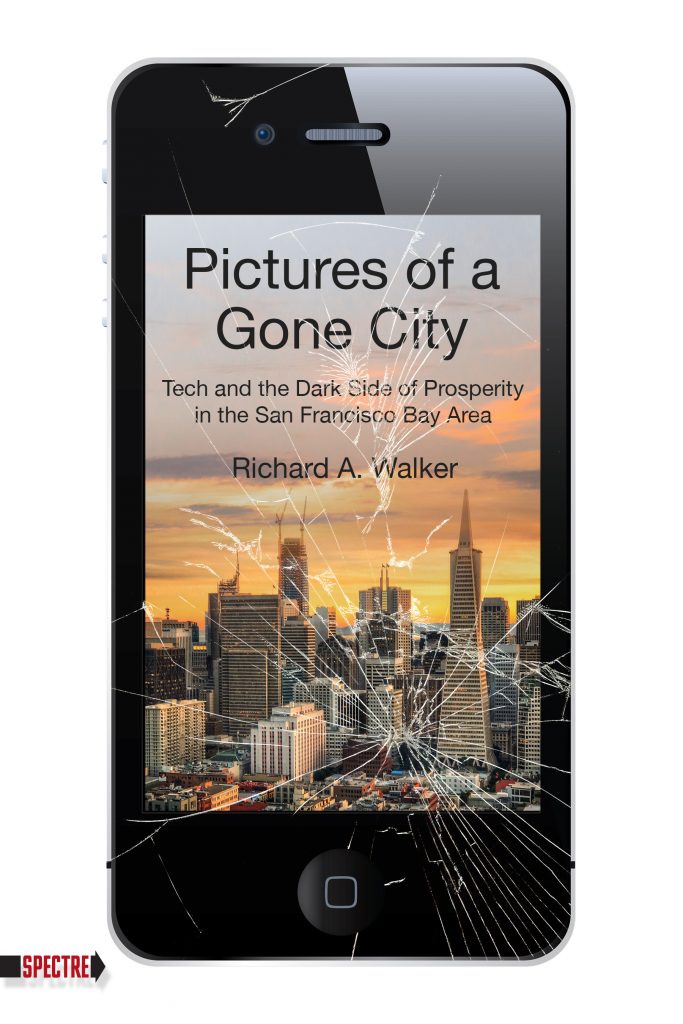By Martin Nicolaus
Berkeleyside
May 16th, 2018
When I first moved to the Bay Area decades ago, someone steered me to Malcolm Margolin’s The Ohlone Way. I became enraptured by this classic study of what the Bay Area looked and felt like before the European occupation. In the intervening years, I’ve tried to keep my eyes and ears open to current realities. But I have to admit that I’ve not been able to form as comprehensive and vivid an image of my adopted home region today as Margolin conjured up about the original inhabitants.
That is, until I read Richard Walker’s new book, Pictures of a Gone City: Tech and the Dark Side of Prosperity in the San Francisco Bay Area.
The “Gone City” in the title comes from a 1951 poem by Lawrence Ferlinghetti, “Pictures of a Gone World.” It’s a bit misleading, in that neither Ferlinghetti nor Walker are mourning the loss of a real or imagined better world in the past. What’s “gone” after reading the works — and this applies both to the poem and the treatise — is the illusion of untarnished beauty and glimmering perfection in the present.
Walker doesn’t stint in painting the positives. His is a broad canvas, covering the 12-county greater Bay Area and sometimes much further beyond, as befits a region with dense national and international connections.
These bright lights sharpen the contrast with the dark side. There is plenty of it, starting with wealth inequality. The top 1% has become vastly more wealthy. The top half of 1% takes home more than 20% of of state income, a ratio that is markedly more skewed than in the rest of the country. The Bay Area has more high net worth individuals and more billionaires per capita than any other city, including New York.
At the center of the picture is Tech World — the industry that employs only about one tenth of the region’s working population but touches billions of lives every day. One sixth of all patents issued in the US originate in the Bay Area, twice as many as New York. In terms of its Gross Domestic Product, the Bay Area alone would rank among the top 20 countries in the world. It has been the primary growth engine for the state of California, which itself is the fifth-largest economy in the world, greater than France and Brazil. Of all US regions, the Bay Area has made the fastest recovery from the Great Recession of 2008. Walker marshals a broad range of indicators to underline the stellar achievements of the Bay Area economy, led by tech. In his words, it is “capitalism’s shining star today.”
The top fifth of wage earners are also doing well, although not in the same league as the upper handful. They earn about five times as much as unskilled workers, a much higher ratio than nationwide. They are almost entirely white, with a few Asians, fewer women, and almost no African Americans. But their numbers are shrinking slightly, and the numbers of the middle third are definitely shrinking.
There are other contradictions. The Bay Area is famously liberal, with a long history of labor militancy which Walker reviews in colorful detail. Not only labor, but civil rights, feminism, immigrant rights, gay and lesbian rights, Native American and other movements marked the Bay Area as the proverbial “Left Coast.”
The bottom stratum of the workforce are paid less than half of the regional average. A majority of them are women and/or minority, including recent immigrants. Two thirds are paid the minimum wage. Benefits like pensions and health care are mostly not in their reach. The poverty rate is close to 20% by federal measures, higher by other indicators. One in four people in the Bay Area is at risk of hunger. By the Gini coefficient, a measure of social inequality, the Bay area is on a par with Guatemala.
But the most reactionary and punitive vision of criminal justice nationwide also originated in large part in California, particularly in the Central Valley agribusiness cauldron. California’s gulag is the largest in the world both in absolute numbers and per capita, and its most crushing weight falls on young men of color.
Wages of the upper sections of the tech industry are higher here than equivalent jobs elsewhere in the country. These incomes are possible because the tech industry floats on a flood of capital extracted from huge numbers of underpaid workers in places like China, Vietnam, Bangladesh and others. With these inflated incomes, the tech professionals drive up housing prices and gentrify formerly affordable neighborhoods.
In a lengthy and detailed analysis, Walker contends that a ballooning of housing demand from several sources to demented proportions is the main cause of the housing crisis. The same dynamic that creates enormous wealth at one extreme generates swelling numbers of homeless people at the other. We are living through the worst housing crisis in Bay Area history, says Walker.
One byproduct is freeways choked with commuters driving hours back and forth to work every day, creating the fourth worst traffic congestion in the world. Central city budgets, once strapped to the minimum, are enjoying a revival. Outlying towns have trouble scraping up the means for the most basic services.
What we have seen in this millennium, Walker shows, is a historic reversal of the postwar white flight to the suburbs. The children of the suburbs, money in hand, have rediscovered the civilized joys of center-city living: brew pubs, nouvelle cuisine, entertainment venues, bicycling, light rail, gaslight retro districts, and all the rest of it. At the same time, the children of inner-city residents are being squeezed out by high home prices and exorbitant rents, and are fleeing to the suburbs and exurbs where housing is cheaper.
There is much else in the nearly 400 pages of Walker’s tome. Every city, every movement, every industry, every issue, every leading mover and shaker gets its due. This is truly an encyclopedic volume. The bibliography alone is 45 pages of small print. The craft of geography, in Walker’s hands — he is an emeritus professor of geography at UC Berkeley — includes sociology, economics, politics, biography, culture, statistics, and much else, blended into a powerful and sensitive analytical tool.
Although deeply learned, the book is free of jargon and “academese.” Walker writes for the educated general reader. His subject matter is at times explosive and infuriating, but he proceeds in a calm and organized way. There are some gaps; for example, in the discussion of California’s environmental issues, there is no mention of fracking. There are also lapses in proofreading, perhaps because the book discusses developments as recent as early 2018. But these are minor in a work of this magnitude.
With a historical perspective going back to the Gold Rush and a scope covering the entire region, concentrating on the world’s most advanced industry, and surveying a complex, ever-developing diversity of people, Pictures of a Gone City is a masterwork. It’s the one book that has helped me get a mental focus on the Bay Area today much as The Ohlone Way captured the area in the distant past. Gone City belongs in the library of every person who wants to know in rich and colorful detail what the amazing Bay Area is really about.







